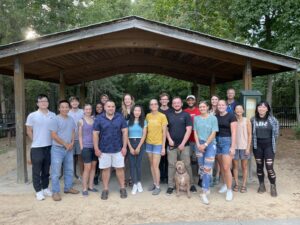Welcome

Our research explores the chemical processes forming and transforming secondary organic aerosol (SOA) in the Earth’s troposphere. Through chemical characterization of ambient samples and controlled laboratory experiments, Professor Surratt has helped to elucidate the chemical pathways leading to SOA formation from the atmospheric oxidation of isoprene, the most abundant non-methane hydrocarbon emitted into the Earth’s atmosphere, which was previously not thought to be a significant source of SOA. Current research in the lab is also exploring atmospheric processing of biomass burning emissions and per- and polyfluoroalkyl substances (PFAS).
We employ advanced on- and offline mass spectrometric techniques to chemically characterize aerosol samples produced in smog chamber experiments and collected from locations around the world. Our 10 m3 indoor smog chamber is used to conduct heterogeneous aerosol chemistry and brief low-NOx oxidation experiments under dark conditions. In addition, the group uses an oxidation flow reactor (Potential Aerosol Mass Reactor, Aerodyne Inc.) to simulate multiday atmospheric oxidation and aging of gases and aerosols.
We chemically speciate organic aerosol constituents from filter samples using gas- and liquid- chromatography coupled to mass spectrometry (GC/MS and LC/MS, respectively), aiming to identify molecular markers of atmospheric chemical pathways. In addition, we use online mass spectrometry techniques to characterize aerosols (using an Aerosol Chemical Speciation Monitor, Aerodyne Inc.) and gases (Chemical Ionization Mass Spectrometer, Aerodyne Inc. & TOFWERK AG.) to understand the rapid reactions and changes taking place in the ambient atmosphere and in our chamber experiments.